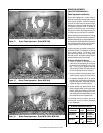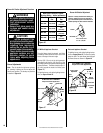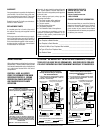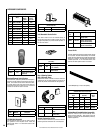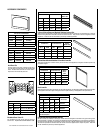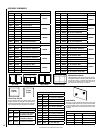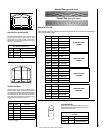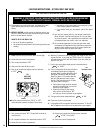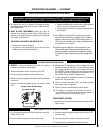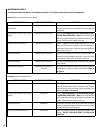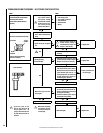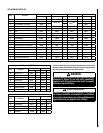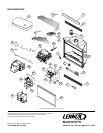
29
Note: Before troubleshooting the gas control system, Ensure external gas shut off valve, located at gas supply inlet, (and wall switch, iff applicable), is
in the “ON” position. Important: Valve system troubleshooting should only be accomplished by a qualified service technician.
SYMPTOM POSSIBLE CAUSES CORRECTIVE ACTION
1. Spark Igniter will not light pilot
after repeated triggering of
Igniter button.
A. Defective igniter
(no spark at electrode).
Check for spark at electrode and pilot; if no spark and elec-
trode wire is properly connected, replace Igniter.
B. Defective or misaligned electrode at pilot
(spark at electrode).
Using a match, light pilot. If pilot lights, turn off pilot and
trigger the igniter button again. If pilot lights, an improper
gas mixture caused the bad lighting and a longer purge
period is recommended. If pilot will not light – check gap
at electrode (igniter rod) and pilot – should be 1/8" to have
a strong spark. If gap measures 1/8", replace pilot (see
Figure 17 on Page 18).
C. Gas supply pressure errant. Check inlet gas pressure. It should be within the limits as
marked on the rating plate.
D. Pilot orifice plugged. Clean or replace pilot orifice.
2. Pilot will not stay lit after
carefully following the lighting
instructions.
A. Defective pilot generator
(thermocouple).
Check pilot flame, it must impinge on thermocouple (see
Figure 17 on Page 18). Clean and/or adjust pilot for maxi-
mum flame impingement on thermocouple. Ensure that the
connection between the valve and thermocouple are tight
and secure.
3. Pilot burning, no gas to burner,
Valve knob “ON,” Wall Switch
“ON.”
A. Limit Switch defective. Isolate the “limit” switch. Disconnect the wires from the
“ON/OFF” switch and the valve (label wires for reattachment).
Test for continuity with a multimeter. If continuity is not
indicated, switch is defective and must be replaced.
B. Wall switch or wires defective. Check wall switch and wires for proper connections. Jumper
wire across terminals at wall switch, if burner comes on,
replace defective wall switch. If okay, jumper wires across
wall switch wires at valve, if burner comes on, wires are
faulty or connections are bad.
C. Thermopile may not be generating suf-
ficient millivolts.
Check thermopile with millivolt meter. Take reading at ther-
mopile terminals of gas valve. Should read 325 millivolts
minimum with optional wall switch “OFF.” Replace faulty
thermopile if reading is below specified minimum.
D. Plugged burner orifice. Check burner orifice for stoppage and remove.
E. OFF/ON Switch & *Remote Switch are in
the "ON" position resulting in excessive
resistance.
When turning on the burner using a *remote switch, ensure
that the unit mounted (optional) OFF/ON switch is in the
"OFF" position. If both switches are in the ON position, it
may result in excessive resistance (& millivolt drainage)
and the burner may not come on.
4. Frequent pilot/burner outage
problem.
A. Pilot flame may be too low or blowing (high)
causing the pilot/valve safety to drop out.
Clean and/or adjust pilot flame for maximum flame impinge-
ment on thermocouple (see Figure 17 on Page 18).
SYMPTOM POSSIBLE CAUSES CORRECTIVE ACTION
1. Burner will not light. A. Faulty Valve System. See Below.
B. “OFF/ON” or wall switch defective. Disconnect the two black wires from the wire nuts. Test
switch(s) for continuity with a multimeter. If continuity is not
indicated, switch(s) is defective and must be replaced.
Note: Before replacing “OFF/ON” switch, Ensure to check
wiring for loose connections or broken wires and repair
as needed.
2. Burners come “ON,” then turns
“OFF.”
A. Burner orifice plugged. Check main burner orifice(s) for blockage. Clean or re-
place.
B. Obstructed vent system. Check vent system for obstructions.
TROUBLESHOOTING GUIDE - ELECTRONIC IGNITION SYSTEM
TROUBLESHOOTING THE MILLIVOLT CONTROL SYSTEM



